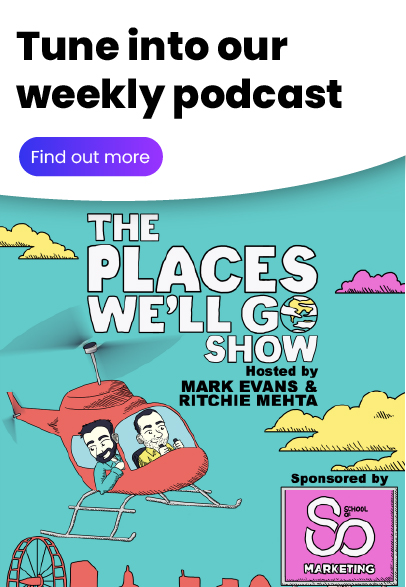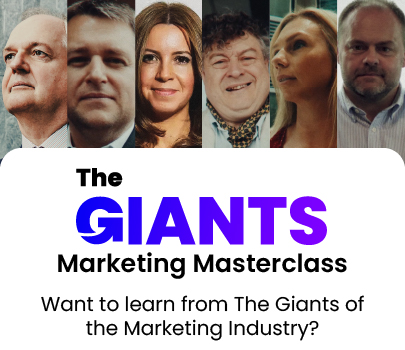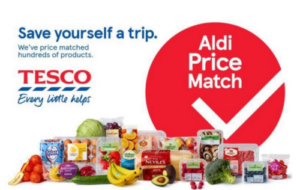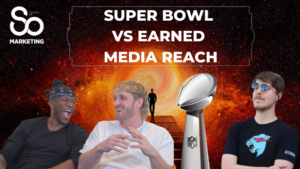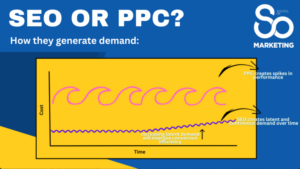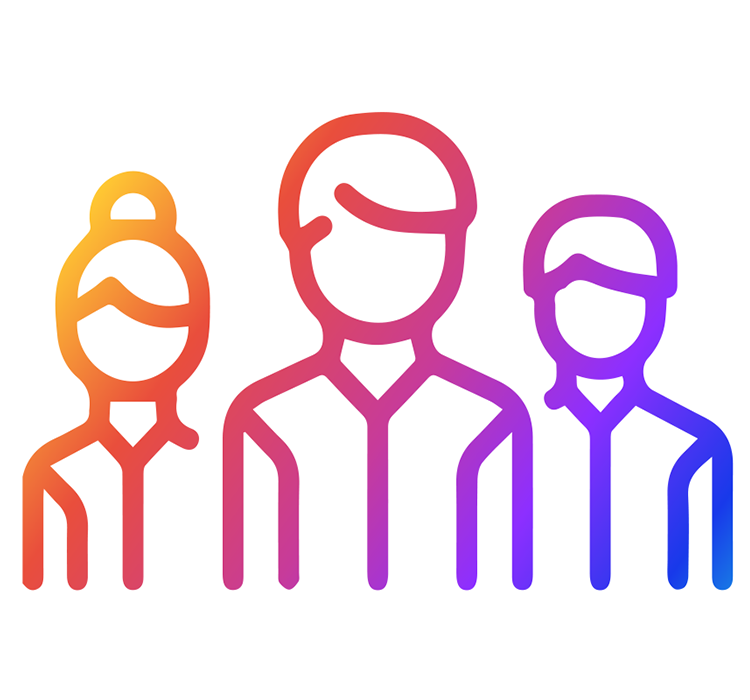The ultimate aim of marketing is to attempt to change the way people think, feel, and act towards a particular brand, product, or service, use behavioural economics to achieve this.
It uses the subtle art of persuasion that is entrenched in behavioural economics, in order to achieve this. It’s a powerful tool that can be used to benefit the organisation, consumer, and society at large. For instance, it can help change consumption patterns, make consumers more empathetic towards charitable causes, or become more conscious of their environmental impact.
To achieve this, marketers must understand the principles of behavioural economics, and be able to apply them when developing and delivering campaigns. It should be integrated into every aspect of marketing from the copy to creative, and even in the execution of media plans.
In this section, we will discuss a few of the most important behavioural economics concepts that will form the bedrock of your ability to convince consumers to think, feel, and act differently.
Consumers feel in charge of their decisions
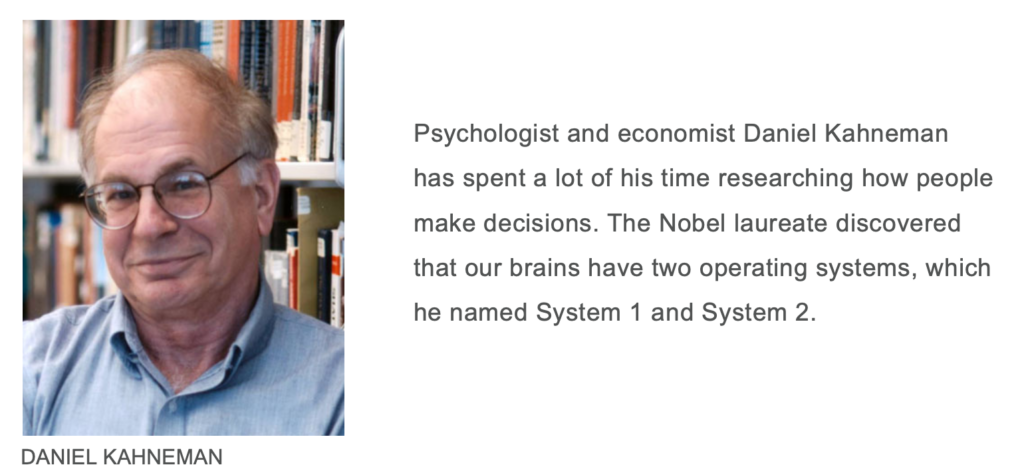
System 1 is the rapid, decision-making engine of the brain in charge of automatic thinking, feelings, and responses. Decisions made using this system are based on familiarity. Whereas, System 2 is the more analytical and conscious part of the brain, in charge of “conscious thoughts,” monitoring behavior, and self-control.
The majority of decisions we make are made using System 1, thinking that is ruled by the subconscious, so we are not often aware why we choose what we do. Interestingly, when a consumer is asked for their opinion on a product or service, or why they bought a certain item, they immediately switch to System 2, the slower, more deliberate, rational part of the brain.
Understanding this distinction is critical for marketers, as there is an inherent limitation in a consumer’s ability to understand why they take certain decisions. One of the primary roles of marketing is therefore, to move a consumer from System 2 to System 1 thinking, so that they can better understand decisions made in relation to their brand, service, or product.
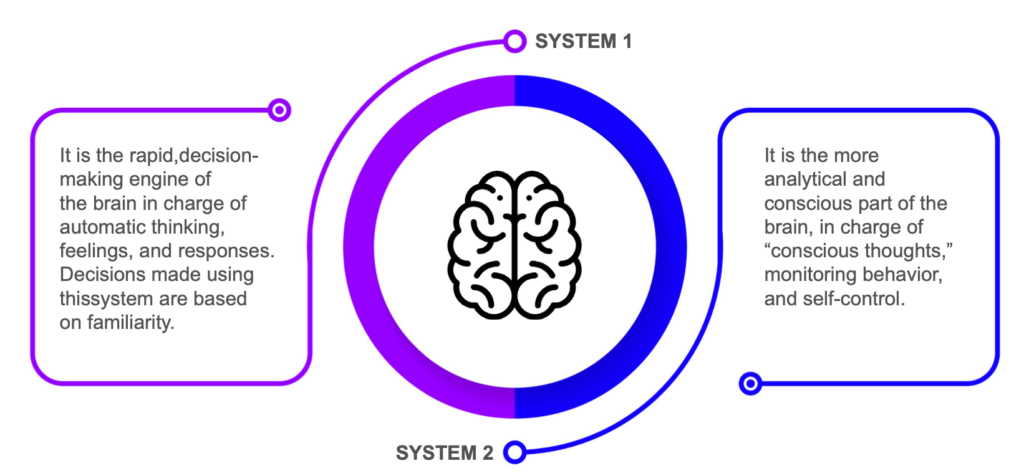
How is this achieved?
There are two ways to achieve this. The first is to increase the familiarity a person has with your product and service. This is achieved by increasing the frequency your product shows up in a consumer’s life, so that the decision to use your brand becomes more familiar and ‘feels right’. Kahneman (2011) suggests that “repetition induces cognitive ease, and a comforting feeling.” Familiarity pays, which is why marketers go to great lengths to induce these comforting feelings in us. As Byron Sharp explains in his book How Brands Grow, “familiarity breeds liking. Usage also breeds familiarity and brand knowledge. This in turn breeds liking.” (Sharp, 2010, p. 91)
Think about how this translates into the world of digital marketing:
- Re-target customers with communications about the brand
- Use organic and paid-for social media advertising to increase the reach and frequency a consumer sees your brand
- Show up in places that a customer constantly goes to, including popular websites and social-media platforms
The second way to improve this is to reduce the cognitive load in making a decision about your brand, product, or service. Have you heard the infamous story of how Steve Jobs (and subsequently Mark Zuckerberg) chose his office attire? Well, it was always the same dull grey T-shirt. He claim that dressing in the same shirt allows him to focus his energy on more important decisions at work.
So how do you reduce the cognitive load? Well, just follow the acronym KISS: Keep it Simple, Stupid. Make it as clear, plain, and simple what you would like the person to do. Make the signage easy to follow, list instructions in a few bullet points, and show them the results of their actions. By removing cognitive barriers, you are making it easier for them to make a choice.
Behavioural Economics Technique 1: Leverage social proof
Entrepreneur Daniel Priestley once stated, “Most great businesses grow because of what others are saying about them.” (Priestley, 2014, p. 178). Examples of this include Amazon’s customer reviews and Google’s rating system.
On some level, we all have the innate desire to be liked, to be seen as popular, and to be part of a group. We often ask peers what decision they took in a particular situation, as it helps us make up our own minds. It’s a behavioural economics phenomenon known as social proof.
You can use the concept of social proof to leverage what others are saying, and how they are behaving towards your brand. There are various ways that you can use to do this. One is by using the ‘people-like-you-did-this’ feature. Another is by showcasing survey results in the brand’s favour, which is also a popular form of advertising. This can be even more effective when a trusted group of people recommend the brand. For example, toothpaste brand Sensodyne gets dentists to talk about the advantages of its product.
You could also make recommendations based on what an individual has chosen in the past, or based on some future state they are likely to inhabit. You could also ‘match’ the user to an outcome, based on their characteristics and preferences.
These are a few ways in which you can use what you know about the person to aid their decision-making process. Ensure the process is easy, and demonstrate what you think is the best approach for them.
Technique 2: The anchoring effect
Theorised by Tversky and Kahneman (1974), anchoring is a cognitive bias from behavioural economics where individuals rely too much on initial or accepted information when making subsequent judgements or decisions. As humans, we need an anchor, or a benchmark that we can use, relative to our own position. For instance, in an experiment by Kahneman, it was found that people preferred to work for less money, if their salaries were higher than those of their colleagues. So, if you ask someone to work for $30,000 when those around are working for $25,000, they will be more satisfied than if they are offered $35,000 while everyone else is earning $40,000.
In another experiment, Salganik, Dodds, and Watts monitored people who were navigating a website where music could be downloaded for free. The study found that for many songs the first review of a song influenced the entire trajectory of ratings. (Christakis & Fowler, 2011). In the absence of other reviews, first reviews act as an anchor, set preconceptions about quality, and influence subsequent perceptions, and reviews.
To further understand how you can put the anchoring effect to work, reflect for a moment on your perception of what is the fair value of a product. If you think about it, your perception of a fair price is to some degree determined by the price the seller asks: The higher the price, the higher the perceived value of the product, and the more willing you are to pay a price in the range set by the seller. By contrast, if the same product is positioned at a lower price point, the lower price provides a cue, indicating a lower value, a value that you now assign to the item itself. You will perceive any subsequent increases in price as unfair. Notice that the same product’s value is being perceived differently, based on the price point you initially set as an anchor.
This type of psychological effect can also be used to position your product within a certain category.
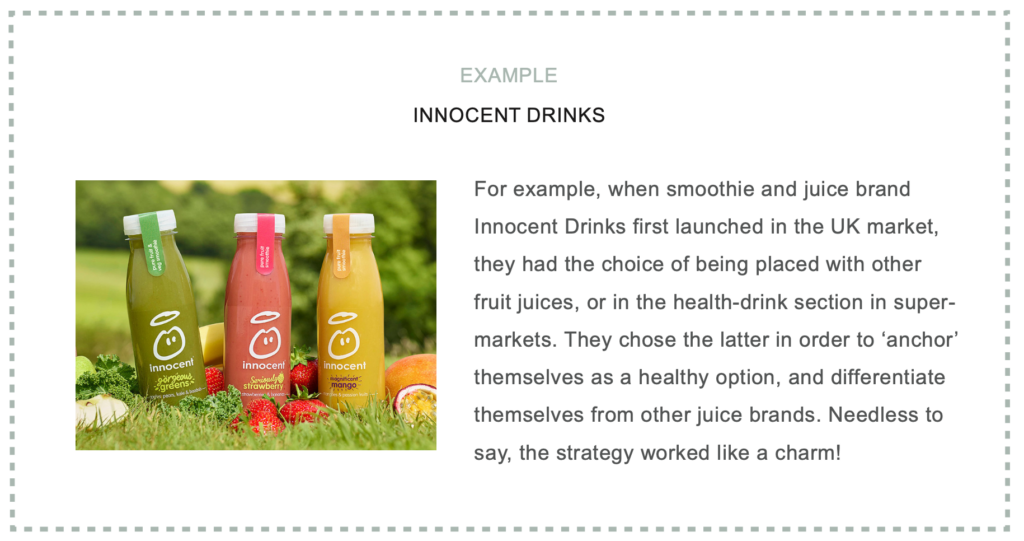
How can you use the anchoring effect in marketing?
- Use comparison tables and pricing methods
- Compare your product to others in the category
Behavioural Economics Technique 3: Embrace the Principle of Reciprocity
When providing value to your clients and customers, it’s worth noting the Principle of Reciprocity that dates back to the 1960s, but was popularised in the context of marketing by marketing professor Dr Robert Cialdini.
According to the principle, if you do something for someone (without any expectation that they will do the same for you), the person is likely to feel obliged to return the favour. This sense of indebtedness can be used to foster a strong relationship in the long term.While it might seem counterintuitive to go against the altruistic premise of the gesture, let us explore how this can work in a marketing context.

‘Freemium’ is a pricing strategy that is used to provide a basic service or product, free of charge. This creates a psychological bond, and an unspoken agreement with your customer that if they find the service or product useful, they will be inclined to sign up for the premium package. A good example of this principle at work is online music-streaming platform Spotify that offers an ad-free version of their service, as well as a premium subscription.
Make people feel valued, and like they are unique. B2B brand builder Dave Gerhandt suggests that marketing has a low benchmark, and it’s about making a customer feel like you care about them. Gerhandt says, “Let’s get this straight. Drizly (an alcohol e-commerce platform) made a mistake with an email. Apologised for it and made a little joke. And now there are viral articles about that email. This is what I mean when I say the bar is low in marketing. Being real is the easiest marketing strategy.” By doing this, people feel valued and that companies are accountable to them and, in return, customers will feel accountable to the company.”
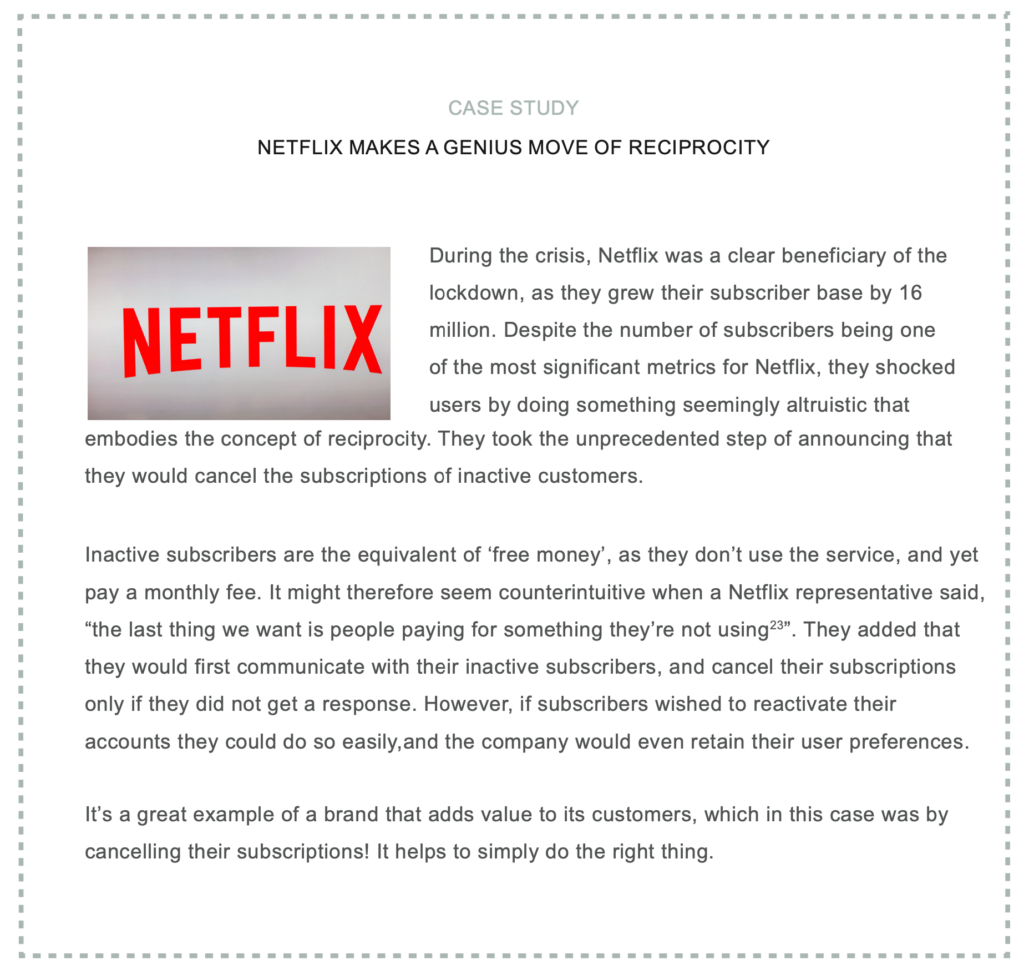
Technique 4:Triggering emotion creates action
Emotional contagion, the phenomenon in which we tend to catch and express the same emotion as others, is widely used by digital marketers, particularly when it comes to video content. Take the example of charities that often screen horrific images of suffering and pain in the attempt to get viewers to sympathise with victims, and take action.
In reality, it has been found that the best, most creative, and impactful campaigns all trigger a sense of emotion.
Behavioural Economics Technique 5: Nudge Theory
Developed by Cass R. Sunstein and Richard H. Thaler, Nudge Theory is a concept in behavioural economics that can also be applied to internal marketing in organisations.
Thaler and Sunstein’s widely used definition of “nudging” is, “any aspect of the choice architecture that alters people’s behaviour in a predictable way, without forbidding any options, or significantly changing their economic incentives. To count as a mere nudge, the intervention must be easy and cheap to avoid. Nudges are not mandates.”
Its basic premise is the ability to nudge someone through encouragement, inspiration, and clever design to change the way they think and act in response to a certain situation. It influences decisions through small suggestions and positive reinforcements. It is self-satisfying to the extent that individuals often think that they are in charge of their own decision and actions, and therefore there is no need for a ‘carrot-and-stick’ approach.
Post the Financial Crisis of 2008, the UK government invested heavily in the development of a ‘Nudge Unit’, formally known as the ‘The Behavioural Insights Team’ (BIT). This was shortly followed by other countries, including the US, where fPresident Barack Obama inaugurated the ‘Social and Behavioural Sciences Team’.
It focuses on how organisations craft the various choices people can opt for. This approach can take “into account the difference in feelings, opinions, and knowledge of people and also considers the reality of the situation, as well as the characteristics of human nature and behavior. It thus minimises resistance from employees of a company, and is very well applied in several industries.”
How can it be implemented in marketing?
Nudge theory goes to the very heart of the design process and how each element is developed to help reframe the thoughts and actions of the team. Richard Thaler said, “there’s no such thing as ‘neutral’ design. Small and apparently insignificant details can have major impacts on people’s behavior.”
There is a useful framework that the UK BIT created in order to help organisations implement ‘nudge’ approaches that help influence others. They developed the mnemonic EAST (Easy, Attractive, Social and Timely) that can be used to help companies when trying to influence individuals to change the way they think and act.
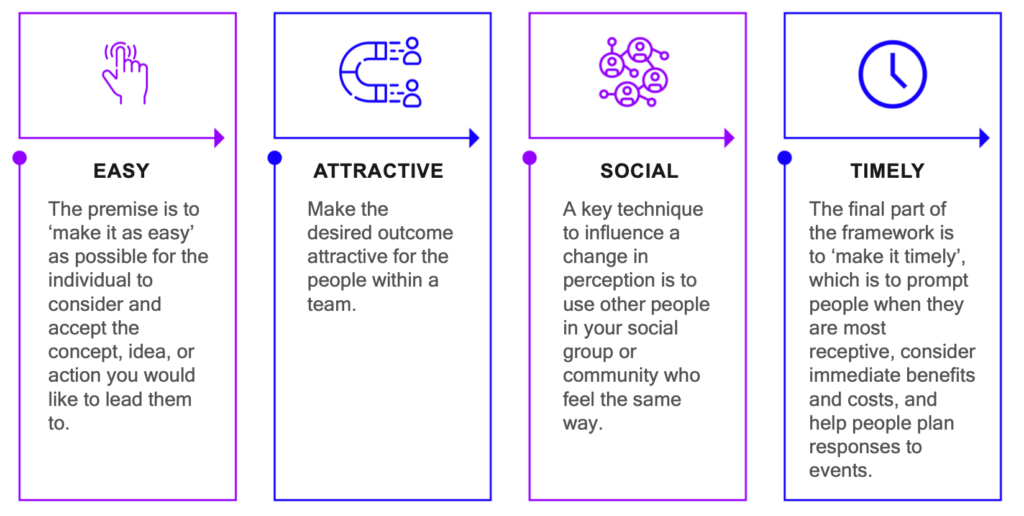
Easy: The premise is to ‘make it as easy’ as possible for the individual to consider and accept the concept, idea, or action you would like to lead them to. A good example is creating a roadmap that is detailed and easy to understand. This can also be achieved by creating minimal resistance to existing and established ways of working. A good example of this is when the UK government anticipated a future ‘pensions and retirement’ crisis. In order to gain buy-in from stakeholders, they set up automatic enrolment into pension schemes. This was designed to harness the power of defaults and resulted in pension participation skyrocketing from 61% to 83%. Pension enrolment isn’t mandatory. However, by making it easy for people to apply, they were more inclined to participate rather than opt out.
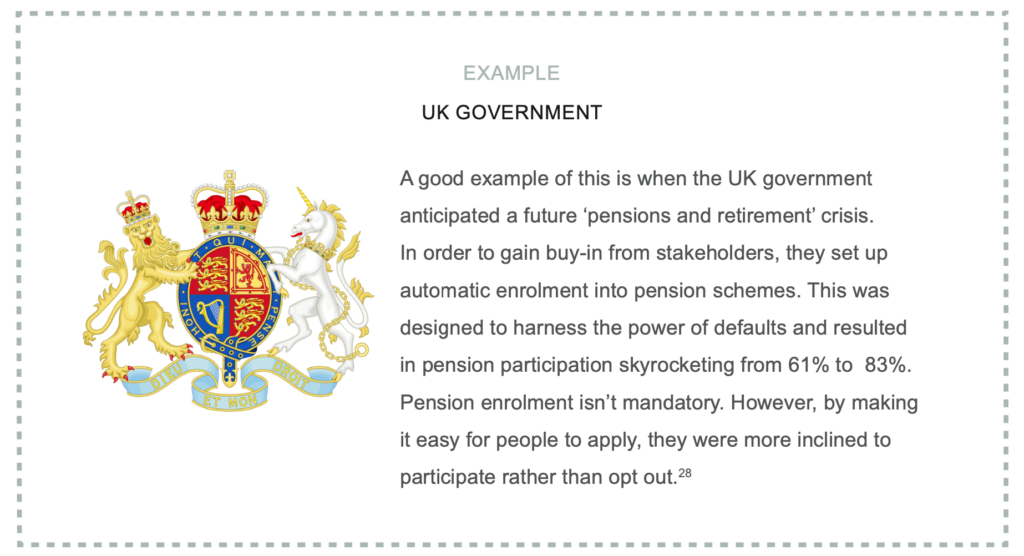
Attractive: Make the desired outcome attractive for the people within a team. In order to get buy-in from people and get them to see a ‘new way’, it’s important that they are able to get something from the design, or messaging that resonates with them. The common phrase that “people only see what they want to see” is a form of confirmation bias. This is where individuals will buy into an idea, if it confirms their own views and preconceived notions. Therefore, it’s important to maintain elements of existing thinking when ‘nudging’ them to change their perspective.
Social: A key technique to influence a change in perception is to use other people in your social group or community who feel the same way. This serves as positive reinforcement, which gets others to be influenced, as they don’t want to be left or singled out for deviating from the norm. When trying to change the thoughts and actions of teams, it’s worth getting the buy-in from key influencers and others, who are similar to the types of people you are looking to influence.
Social pressure is a key technique used by self-help groups in countries like India and Bangladesh, where a group of women form an aggregate savings fund that is used to supply micro-loans to the community. The pay-back rate is amongst the highest (in the region of 98%) in many areas, as there is significant social pressure to not be seen as the person who did not pay back.
Timely: The final part of the framework is to ‘make it timely’, which is to prompt people when they are most receptive, consider immediate benefits and costs, and help people plan responses to events. Periods of significant upheaval are a good time to prompt change, particularly since it’s on everyone’s mind. Therefore, using the event as a catalyst for change is likely to increase buy-in. This was clearly demonstrated through the pandemic, as people moved from face-to-face training practices to virtual ones, within weeks, in spite of previous resistance.


